Strategies to Help Your Senior Dog Stay Strong and Mobile
Just because your dog is growing older doesn't mean he needs less activity. By staying active, he can maintain muscle tone and balance to help him enjoy his senior years. In addition to short, frequent walks, try these special exercise and massage techniques.
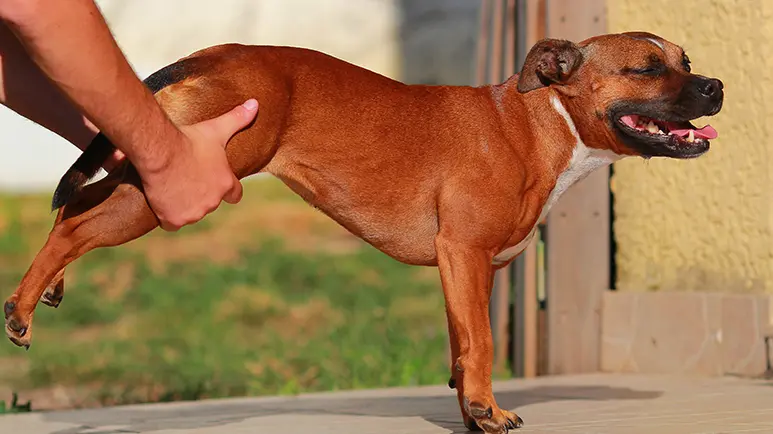
STORY AT-A-GLANCE
- Senior dogs need to stay active no matter their age
- Strategies to help older dogs stay mobile include targeted strengthening exercises, balance and proprioception (body awareness) exercises and passive-range-of-motion exercises
- Gentle stretching exercises that focus on the hips, shoulders and back can very beneficial
- Massage is also helpful to improve circulation, relax tense, tight muscles and ease the stiffness of arthritis
- Chiropractic, acupuncture, hydrotherapy and appropriate joint supplements can also be extremely beneficial for older dogs
By Dr. Karen Shaw Becker and Sarah MacKeigan, Physiotherapist and Canine Rehabilitation Therapist
Editor's Note: This article is a reprint. It was originally published September 20, 2019.
Just as we need to stay active to fully enjoy our senior years, so do our canine family members. One of the challenges we face with older dogs is that the aging process can lead to a vicious cycle of decreased muscle strength, increase in muscle stiffness and an overall decrease in balance. The result tends to be more time spent inactive, which then leads to weight gain and added stress on those joints that are no longer well supported by adequate muscle mass.
The good news is that with your help, your older pet can break the cycle and gain tremendous benefits from anti-aging activities. Short, frequent walks with your dog are beneficial to maintain heart health. In addition, consider:
- Exercises specifically designed to maintain strength, flexibility and balance
- Gentle stretching exercises focusing on the hips, shoulders and back
- Massage to relieve sore muscles and joints, and other aches and pains
Exercises to Help Maintain Strength, Flexibility and Balance
There are three types of exercises that are beneficial for aging bodies:
- Exercises that target the big, body-supporting muscles like the quadriceps, hamstrings and gluteals
- Exercises that maintain balance and fluid movement
- Passive range-of-motion (PROM) exercises for joint health
Targeted strengthening exercises — We asked Sarah MacKeigan, licensed human physiotherapist and canine rehabilitation therapist, of Upward Dog Rehab, for some basic suggestions to help keep seniors moving well. These exercises in older pets are designed to work the big muscle groups that help with standing, walking and running. These exercises should be done three to five days a week. It's best to do them on a firm and non-slippery surface.
The sidestepping and backing up exercises strengthen the glutes and lateral thigh muscles. Stand facing your dog's side, with one hand on her collar and one hand on the opposite hip. Step into your pet until she steps to the side with a lateral move, but no forward motion. To back up, stand in front of her and guide her nose in toward her chest while asking her to back up. If she is looking up at you, you may find she sits instead. You can start with three to five steps in each direction and work up to 10 to 15 steps in each direction.
For step-ups (also called two up, two down or paws-ups), have your pet put both front feet up on one step, which shifts her weight to her hind legs. The higher the step, the greater the demand therefore gradually build the height beginning around 6 inches. Hold the position for 60 seconds. Start with one and work up to three repetitions.
If you want to try three-legged stands, while your pet is standing, gently pick up one of her paws, which will cause her to shift her weight onto the other three paws. This helps build strength and balance. Hold the position for 10 to 20 seconds and repeat with each limb.
For sit to stand, have your pet sit and then have her stand right away. Repeat the action and offer treats to keep her interested. Watch for signs of fatigue such as rolling to one hip or pulling up with her front legs, and if you see any, don't do any further repetitions in this session. Gradually build up 10 to 15 repetitions in one session.
When introducing new exercises, start slow and build up gradually. If your dog doesn't want to do them and starts off well but loses form (i.e., off weighting) it may be due to muscular fatigue or weakness. If you suspect something maybe wrong or that she's injured, contact your veterinarian.
Balance and proprioception (spatial orientation and movement) exercises — These exercises include the use of cookie stretches, which are exercises that help older pets remain flexible while also encouraging improved balance and physical stability. Cookie stretches include spinal extension, spinal flexion, lateral spinal flexion and lateral spinal flexion with rotation.
The cookie is offered from various angles to encourage stretching in different directions. The cookie stretch starts with your dog in a standing position. You can bring the cookie slightly out and up from his nose for extension and in towards the chest for flexion. Lateral flexion and rotation is achieved by bringing his nose slightly down with the cookie and then around towards his shoulder or hip. It works best when you stand on his opposite side. The goal is to have him reach for the cookie without taking any steps.
The dog is rewarded when he reaches the desired position. Short holds of four to five seconds help with spinal mobility and proprioception. The exercise can be made more challenging by requiring your dog to hold the position for 10 to 30 seconds (see section on stretching the back, below).
Another exercise to improve balance, strength and flexibility involves either walking or high stepping a pet over Cavaletti poles. Start with two or three poles on the ground and build up to various heights over time. Encourage walking over the poles, not jumping.
Passive range-of-motion exercises — PROM exercises can benefit both incapacitated and physically healthy pets as it is excellent for maintaining joint health. They are performed on a pet who is lying on her side in a comfortable position. The limbs are gently and slowly flexed and extended one at a time. It's important to keep the leg's position parallel to the body wall to avoid torque on the joints.
It's also important not to hyperextend the wrists or ankles. Watch for sore and sensitive areas and only move the joint as far as your pet is willing. Passive range-of-motion exercises include:
- Forelimb flexion
- Shoulder flexion + elbow extension
- Hind limb flexion
- Hip and stifle extension
- Shoulder and elbow extension
- Shoulder abduction
- Hip flexion + stifle extension
- Hip abduction
Stretching Exercises for the Hips, Shoulders and Back
Stretches are best done after exercises (not before). There are three areas of your dog's body for which stretching is especially beneficial — the hips, shoulders and back. The following stretches, done slowly and gently, are well-tolerated by most dogs. Instructions for most of these stretches have your dog standing, but you can also do them with your dog lying on his side, or in the case of the chest stretch, on his back. Some dogs are very uncomfortable in this position, so if yours is, don't force the issue.
Needless to say, if your pet shows any sign of pain during stretching (or the other hands-on therapies discussed here), discontinue the movement and have him seen by your veterinarian as soon as possible.
- Stretching the hip flexors — The hip flexors are muscles that enable your dog to move his legs and hips forward while walking, trotting or running. To stretch the hip flexors, ask your dog to stand, and grasp a back leg above the knee. Gently and slowly move the leg back straight out behind his body.
When you reach a point of resistance, where further extension will require applying pressure, hold the leg in position for about 15 to 30 seconds, as tolerated by your dog. Never force him to hold a stretch he doesn't want to. Repeat this stretch two or three times with each back leg. In standing, you may find you need to support him under his belly with your leg, arm or a pillow (depending on his size).
Benefits your dog will receive from this stretch include increased movement and flexibility in the hips and spine, improved conditioning of the lower back, hip and leg muscles and a reduction in arthritis-related discomfort and pain.
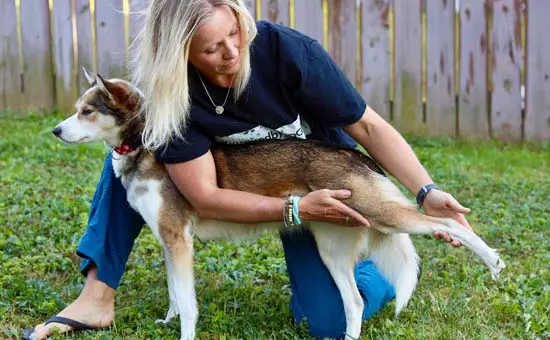
- Stretching the shoulder flexors — Shoulder flexors are muscles that allow fluid movement and proper use of your dog's front legs. To stretch the shoulder flexors, with your dog standing, grasp a front leg above the elbow, place your other hand under the elbow to stabilize it and gently move the leg forward (imagine you're teaching your pet to do a "'high-five").
At the point of resistance, hold the position for 15 to 30 seconds and repeat two or three times for each front leg. You can support your dog on the opposite side with your body, if needed. Not only does this stretch improve the integrity of shoulder structure, it also benefits the wrists and elbows, and increases your dog's breathing capacity by loosening her chest muscles.
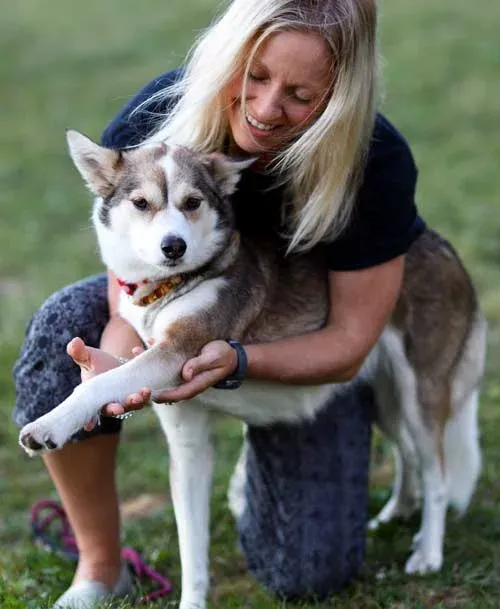
- Stretching the chest area — The muscles of your dog's chest endure a great deal of strain. This is an abduction stretch, meaning a stretch away from center. With your dog on his back, grasp both front legs near the wrists and gently open them out to the side. Hold for several seconds, release and repeat.
Since your dog may expect a chest or tummy rub (he's on his back, after all), you can relax him further by giving him a gentle chest massage using light pressure and circular strokes.
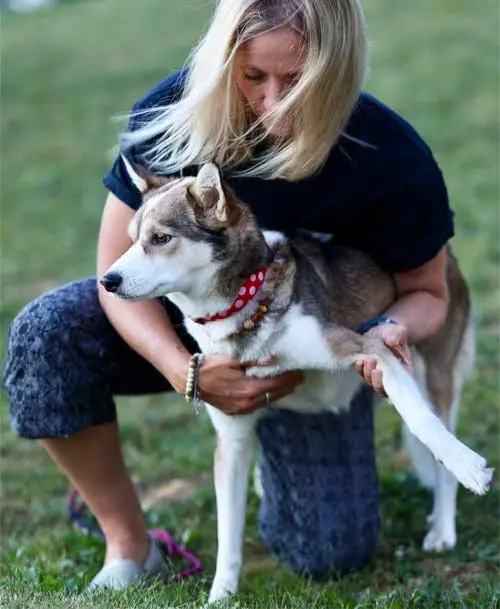
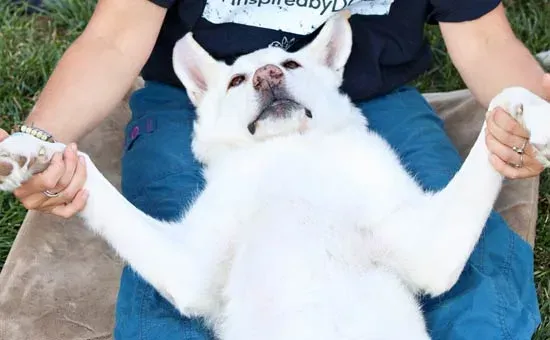
- Stretching the neck and back — This stretch requires the use of training treats. Again, with your dog standing and you on one side of her, move the treat slowly in the direction of her tail, encouraging her to follow it with her eyes, turning only her head. This will require her to bend her body into a C shape. Hold her in this position for 15 to 30 seconds, then step to her other side and repeat the exercise. Do two or three stretches on each side.
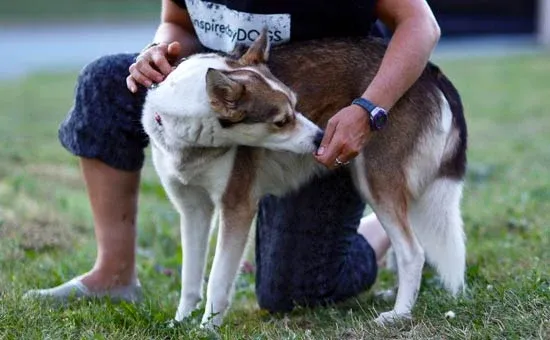
After you've stretched your dog's back, she'll really enjoy a sacrum and back rub. The sacrum is the area in front of the base of the tail, between the hip bones. Using light pressure and circular movements massage the hard, flat surface of the sacrum. Move your hands slowly up your dog's spine and back using gentle massage strokes.
Regular sacrum and back rubs decrease anxiety, increase the flow of spinal fluid, enhance mobility in the hips and spine, and help bring your dog's body into balance.
Massage for Older Dogs
Pet massage, especially for older furry friends, is different from human massage. The technique for dogs involves slow, gentle strokes and stretches, combined with light, rhythmic tapping. Benefits of regular massage for pets:
- Helps keep your senior dog's muscles toned and reduces the slackening that comes with aging
- Massaged muscles are looser, which makes it much easier for your dog to move around comfortably
- Massages improve circulation and encourage lymphatic drainage
- Regular massage also eases the stiffness of arthritis, which can help your pet maintain his normal gait and active lifestyle
- Massage loosens the muscles around joints, which also helps promote ease of movement
The hands-on therapies (PROM, stretches and massage) should feel good for your pet, and both you and he should be relaxed and engaged in what you're doing. If he isn't comfortable or is resisting something, not only does it not have the desired therapeutic benefit, but it may indicate soreness.
If you don't feel confident in your ability to do hands-on therapies, consider asking your veterinarian, a small animal chiropractor, a canine rehab therapist or a professional small animal massage practitioner to teach you, so you can do them at home. If you suspect pain, discontinue the movement and have your dog seen by your veterinarian as soon as possible.
More Strategies to Help Keep Their Aging Body Comfortable
Encouraging your dog to stay physically active throughout life will help alleviate the aches and pains of an aging body, but it's still important to watch for signs of pain. If your pet seems physically uncomfortable, a visit to your veterinarian is in order. The sooner a health problem is diagnosed and treated, in most cases, the better the outcome.
Keeping your furry family member at a healthy weight and physically active will help control arthritis and degenerative joint disease as she ages. Chiropractic adjustments, water exercise and acupuncture can also provide enormous benefits in keeping pets mobile in their later years.
There are a wide range of supplements that can be added to your pet's diet to help maintain healthy tendons, ligaments, joints and cartilage. These include:
- Glucosamine sulfate with MSM and eggshell membrane
- Omega-3 fats (krill oil)
- Ubiquinol
- Supergreen foods like spirulina and astaxanthin
- CBD oil or capsules
- Natural anti-inflammatory formulas (herbs, proteolytic enzymes and nutraceuticals)
In addition, talk to your veterinarian about Adequan injections, which can stimulate joint fluid very rapidly in pets with arthritis.











